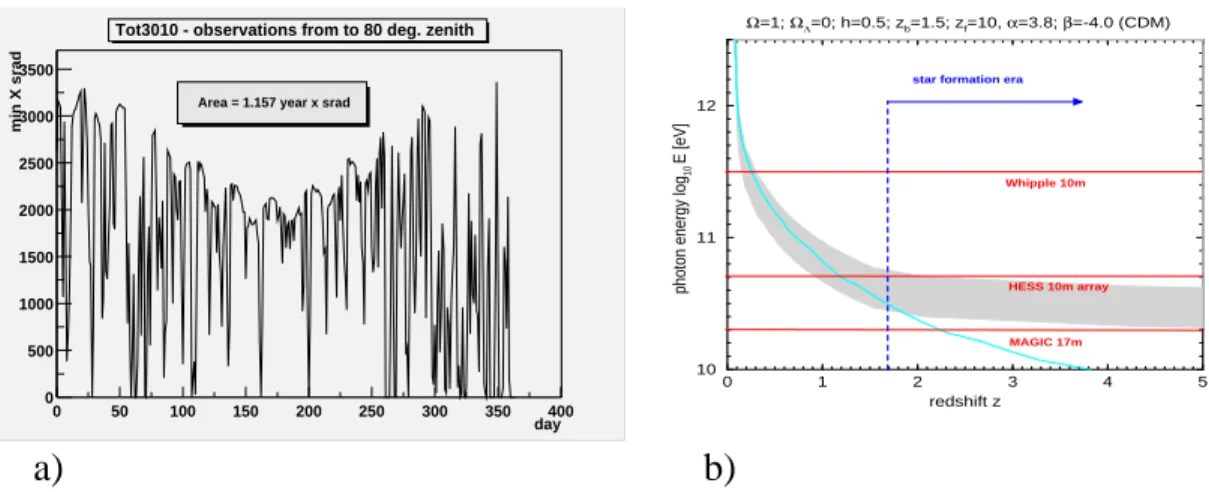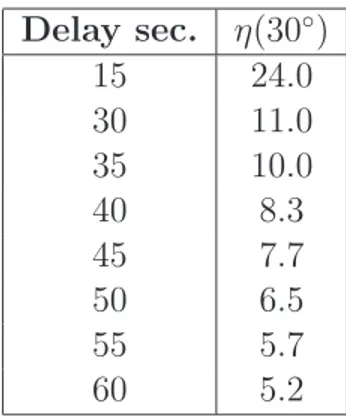28th International Cosmic Ray Conference 2753
The MAGIC Telescope and the Observation of Gamma Ray Bursts
N. Galante,4 D. Bastieri,3 M. Gaug,1 M. Garczarczyk1 and L. Peruzzo3 for the MAGIC Collaboration.
(1) Institut de F`isica d’Altes Energies, E–08193 Cerdanyola del Vall´es, Spain (2) M. Planck Inst. f¨ur Physik, F¨ohringer Ring 6, D–80805 M¨unchen, Germany (3) Universit`a and INFN Padova, Via Marzolo 8, I–35131 Padova, Italy.
(4) Universit`a di Siena and INFN Sezione di Pisa, Via F. Buonarroti 2, I–56127 Pisa, Italy.
Abstract
The MAGIC Telescope, with many technological innovations which allow the telescope to have a low energy threshold and a very fast slewing time, could be one of the first ground based experiments able to see transient phenomena like Gamma Ray Bursts. In this paper we present a study on the MAGIC Telescope possibilities to observe GRBs, obtaining a result of 0.5÷2 observable GRBs per year.
1. Introduction
The MAGIC telescope has introduced new technological solutions [1] which may allow to observe the high-energy components of gamma-ray bursts for the first time with great significance. Its mirror support structure made of carbon fibre reinforced tubes weighs less than 10 tons and gives the telescope low inertial momentum despite of its huge reflective area of 239 m2. This will allow for a slewing time of less than 30 s to any position in the sky. Together with high efficiency phototubes, the energy threshold of MAGIC will be as low as 15 GeV which is about an order of magnitude lower than the ones for existing IACTs.
In this work we intend to provide a quantitative estimate of the MAGIC capabilities in observing GRBs, taking into account the main constraints which influence GRB observation which are duty cycle, effective area, the time delay to start the observation after the onset of the gamma ray burst, and the amount and the quality of the alerts.
2. Methods
Our criteria to determine the duty cycle were chosen as the following:
• The Sun must be below astronomical horizon at 108◦ zenith;
pp. 2753–2756 c2003 by Universal Academy Press, Inc.
2754
• The minimum angular distance from the Moon must be 30◦;
• The relative humidity of the air must be lower than 80%;
• The wind speed must be lower than 10 m/s;
Taking into account these constraints, we have computed the duty cycle (in srad×time) observable by MAGIC for each day of the year. This duty cycle is meant as an upper limit since it does not include human constraints like main- tenance periods, problems arising during shift, etc. . . The design of the telescope is foreseen to reduce to a maximum these observation time losses.
Once pointed to a GRB position in the sky, the sensitivity of the telescope could limit a GRB’s observability. We calculate the significance Nσ of a GRB detection as follows:
Nσ =Q(Ron−Rof f)T
(Ron+Rof f)T =Q Rγ
√T
Ron+Rof f
(1) whereRγis the convolution of the effective areaAef f(E, θ), which depends on the energyE and the zenith angleθ, with the flux dtdEdAdN emitted by the GRB;
Rof f is the simulated hadronic rate (∼ 460 Hz) and T is the acquisition time.
Q is a quality factor wich reflects the gamma-hadron separation efficiency. A GRB is considered observable if Nσ ≥ 5. We used a subsample of particularly bright bursts out of the 3rdand 4thBATSE cataloges (see [2][3]), and extrapolated their fluxes to MAGIC energies (≥15 GeV) following power laws with differential spectral indexes and normalization coefficients provided by BATSE catalog for each GRB. Spectral cutoff due to cosmological absorption has been taken into account. Since the high energy tail of GRBs is still unknown, the Fireball Model has been used to extrapolate the GRB fluxes to MAGIC energies [9] predicting pure synchrotron emission and GRB spectra with no change in the power-law at high energies [8].
3. Results
Figure 1.a) shows the duty cycle calculated for each day of the year 2001.
The number of observable GRBs per year is calculated as NGRB =
θ
D(θ)η(θ) (2) where D(θ) and η(θ) are the duty cycle (percentage value with respect to 4π srad × year, 1.16 srad× year corresponding to 9.2% of 4π) and the number of GRBs observable by MAGIC per year respectively, calculated on the basis of the 3rd and 4th BATSE catalogues, at a given zenith angle θ. Values forη(θ) lie
2755
0 50 100 150 200 250 300 350 day400
min X srad
0 500 1000 1500 2000 2500 3000 3500
Area = 1.157 year x srad
Tot3010 - observations from to 80 deg. zenith
0 1 2 3 4 5
redshift z 10
11 12
photon energy log10 E [eV]
Ω=1; ΩΛ=0; h=0.5; zb=1.5; zf=10, α=3.8; β=-4.0 (CDM)
Whipple 10m
HESS 10m array
MAGIC 17m star formation era
a) b)
Fig. 1. a) Duty Cycle of the MAGIC Telescope for each day of the year 2001; b) Run of e-folding cut-off energy with redshift.
between 5 and 24 GRBs per year depending in particular on possible variances in the delays from the onset of the GRB until the transmission of its position. The result is 0.5÷2 observable GRBs per year.
4. Discussion
Figure 1.b) shows the optical depth of the inter-galactic medium [6][7][10].
Taking absorption and the redshift distribution of GRBs into account for the calculation of Nσ, we find that the values ofη(θ) are only changed insignificantly.
No particular redshift distribution has been taken into account to fold into, but we have calculatedη(θ) for different redshift values up to 4. Moreover, the estimation ofNGRB has been made using only the britest GRBs of the BATSE cataloge, which is a conservative estimation since the current (HETE II and INTEGRAL) and the future GRB satellites (AGILE and SWIFT) provide alerts with even increased sensitivity. All together, these satellites will give a number of alerts next to a half to the one provided by BATSE. In particular SWIFT and AGILE will be able to transmit the burst coordinates to the ground in less than 10 sec. [4][5] thus the MAGIC Telescope should be able to point to these coordinates in less than 40 sec. from the onset of the burst. Anyway the time delay from the onset of the burst is a strong constraint on the telescope possibilities to observe a GRB. Table 1 shows the values of η(30◦) for different values of this time delay.
5. Conclusion
The MAGIC Telescope has been built with a special eye on a low energy threshold and fast slewing capabilities. These features will allow it to test high- energy gamma emission from GRBs with an unprecedented precision. The number
2756
Delay sec. η(30◦)
15 24.0
30 11.0
35 10.0
40 8.3
45 7.7
50 6.5
55 5.7
60 5.2
Table 1. Values of η(30◦) for various time delays computed at z= 3.
of alerts and their time in transmitting the coordinates of a GRB to the ground will be the main constraints for the telescope to observe GRBs. The studies on the duty cycle of the telescope, on its technical features and the predictions of alert time delays from future satellites missions bring us to conclude that MAGIC will be able to observe directly a few GRBs per year and hence test high energy emission scenarios.
6. References
1. MAGIC Collaboration, Preprint MPI-Phe/18-5, 1998
2. Preece R.D., Band D.L., “The BATSE Gamma-Ray Burst spectral catalog. I.
High time resolution spectroscopy of bright bursts using high energy resolution data”, ApJ Supp., 126, 19-36, Jan 2000
3. Preece R.D., Band D.L., Meegan C.A., “BATSE observations of Gamma Ray Burst spectra. IV. Time-resolved High-energy spettroscopy”, ApJ 496: 849- 862, April 1998
4. Tavani M., private communication.
5. http://swift.gsfc.nasa.gov/public/instruments/bat.html 6. Mannheim K., Westerhoff S., Meyer H., Fink H., A&A, 1996 7. Mannheim K., A&A, 263, 267, 1993
8. T. Piran, “Gamma Ray Bursts and the Fireball model”, astro-ph/9810256, 2 November 2001
9. N. Galante, “Il Telescopio MAGIC (Major Atmospheric Gamma Imaging Cerenkov Telescope) per l’osservazione deiˇ Gamma Ray Bursts”, diploma the- sis, 2002
10. Kneiske, T.M., Mannheim, K., Hartmann, D.H., 2002, A&A 386, 1

